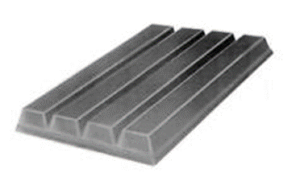25/04/2018
Last week saw the latest development in the 11 year duel of trade mark litigation between confectionery giants Nestlé and Cadbury (now Mondelez). Advocate General, Melchior Wathelet, published his opinion on Cadbury’s on-going invalidity action against Nestlé’s ‘4-finger KitKat’ 3D EU trade mark, in advance of the case being heard at the Court of Justice of the European Union. And it is not good news for Nestlé, and will be making anyone seeking pan-EU protection for 3D marks a little nervous about the evidence required to support their application.
This particular dispute began in 2007, when Cadbury applied to invalidate Nestlé’s European trade mark registration for the shape of its 4-finger KitKat bars. This registered mark bears no other words or images to link the product to Nestlé:

Though the registration was granted by the EUIPO, Cadbury claimed that Nestlé’s mark did not have the distinctive character necessary to perform the primary function of a trade mark – the identification of the origin of the goods or services.
Distinctive character can either be inherent to the mark itself, or acquired through the use of the mark. If, through extensive use of the mark by the applicant in the relevant territory for which protection is sought, the public has learnt to consider the mark as belonging to that particular undertaking, the registration could be granted. The key question here is how much evidence is enough to show acquired distinctiveness and, in particular, what’s the “relevant territory”.
In round 1, the EUIPO Cancelation Division sided with Cadbury and cancelled the trade mark. Nestlé appealed and won round 2, the EUIPO Board of Appeal rejecting the invalidity action and reinstating the trade mark registration. Cadbury then appealed this decision to the General Court of the EU, who overruled the Board of Appeal’s finding of acquired distinctiveness. Round 3 went to Cadbury. The General Court reasoned that Nestlé’s evidence demonstrated acquired distinctiveness in only part of the EU, and this was not enough. Though Nestlé had shown market evidence from 10 of the original 15 EU member states (from the time the application was filed), data were missing from 5: Belgium, Ireland, Greece, Luxembourg and Portugal. So for those member states, there was nothing to show that the mark is acting as a badge of origin for Nestlé’s goods and if the mark cannot be protected in any one Member State, the pan-EU protection of the registration is not valid.
Nestlé appealed that decision, in round 4, to the European Union Court of Justice. That appeal process involves an Advocate General, whose role is to present to the Court their views on the disputed law. Their opinions are not binding, but tend to provide a good indication of the most likely outcome. If the Judges of the Court follow the Advocate General’s reasoning, it will be bad news for Nestlé, but will also raise for everyone questions about the unitary character of the EU market and the assessment of the acquired distinctiveness of a European Trade Mark.
In round 4, Nestlé argued that the General Court was wrong to hold that the proprietor of an EU trade mark must file evidence relating to each of the Member States separately. They argue that the General Court’s interpretation is incompatible with the unitary character of the European trade mark.
In his opinion, the Advocate General acknowledges first of all that it would be unreasonable to require proof of acquired distinctiveness for each individual EU Member State, and refers to precedents at the Courts of Justice to this effect. However, he observes that this does not imply that the party providing evidence in support of a claim to acquired distinctiveness of their trade mark can leave out entire regions and markets. Further, if extrapolation of the evidence on file in the case to consumer perception in countries for which evidence of use was not provided is to be accepted, some evidence should be on file to support such extrapolation. The Advocate General has found no such evidence here.
Unsurprisingly, Nestlé are disappointed with the Advocate General’s opinion and consider it “based on incorrect factual findings”.
Comment
If the Court of Justice agree with the Advocate General, this may set a very high evidential burden for EUTM applicants seeking to prove that a shape mark, if criticised as lacking inherent distinctiveness, has acquired through use the distinctive character to justify pan-EU protection. This could apply to other types of marks including colours, sounds and holograms.
The experience of our team here suggests considering the alternative to pan-EU protection – applying to register such marks in the national registers of each individual country of the EU. Some registries set the bar for inherent distinctiveness higher than others. And if an objection is raised, the evidence of use required will be for that country only. Please contact our trade mark team if you would like further advice.
This article is for general information only. Its content is not a statement of the law on any subject and does not constitute advice. Please contact Reddie & Grose LLP for advice before taking any action in reliance on it.



